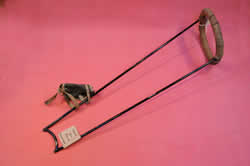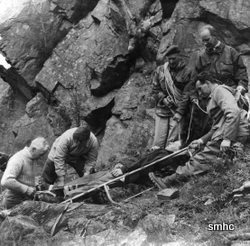
The Scottish Mountain Heritage Collection
Objects Database
Thomas Splint
Accession Number
046.2008.1
Object Name
Thomas Splint
Created
29/03/2008
Creator
Mick Tighe
Accession Date
29/03/2008
Brief Description
Single Leg Iron Traction Splint. Hollow iron tubing, fabric and foam padding with canvas support. Black in colour. Beige padding.
Materials
Iron, fabric, foam, canvas.
Dimensions
112cm (L) x 35cm (W)
Number Of Objects
1
Inscription Description
None
Colour
Black, beige padding
Maker
Unknown
Provenance
Huw Owen Thomas(1834-1891) was descended from a long line of Welsh bone setters and amongst many other achievements in a glittering orthopaedic career he invented the Thomas Splint.
It consists of a proximal ring that fits around the upper leg and to which two long rigid, slender steel rods are attached. These extend down to the smaller ring distal to the foot. This splint has proved of especial value in the treatment of fractured femur and greatly reduced the mortality from this condition. Originally developed to treat hip-joint disease, it is now used mainly to place traction on the leg in its long axis.
Used extensively on the battlefields of WW1 and WW11 this splint came into use almost universally with mountain rescue teams across the UK in the 1950's,60's and 70's. This particular one was used by Lochaber Mountain Rescue Team for many years and must have supported plenty of legs.
Rather confusingly we have another item in our collection of a similar ilk, and created by a man called Thomas, in this case Eustace. The Thomas stretcher (item 646) comes from a different era(1930's) and Eustace was born about the time Huw Owan died. We do wonder if there is a possible family connection.
Acquisition Date
29/03/2008
Condition Check Date
28/04/2009
Normal Location
Bohuntin
Current Location
Bohuntin
Rules
Spectrum : UK Museum documentation standard, V.3.1 2007
Modified
28/04/2009


